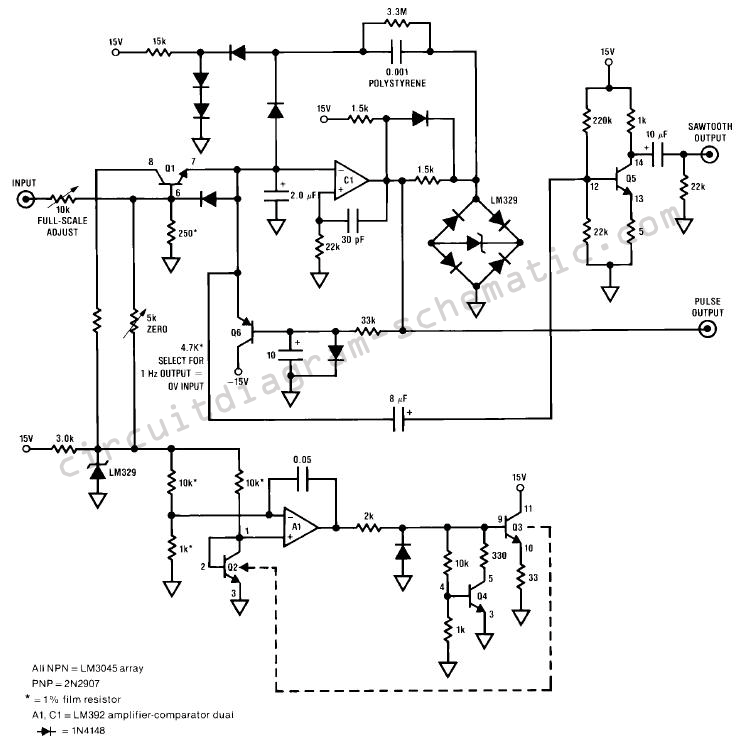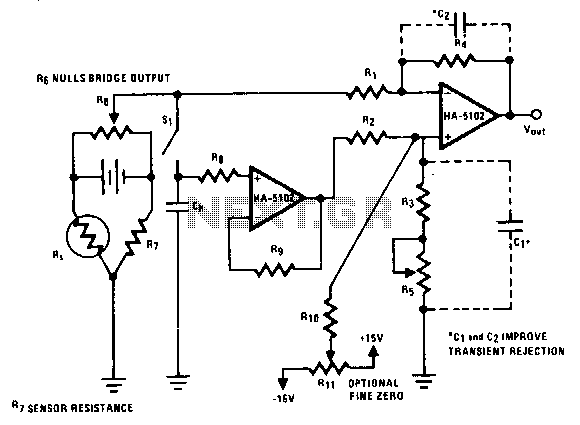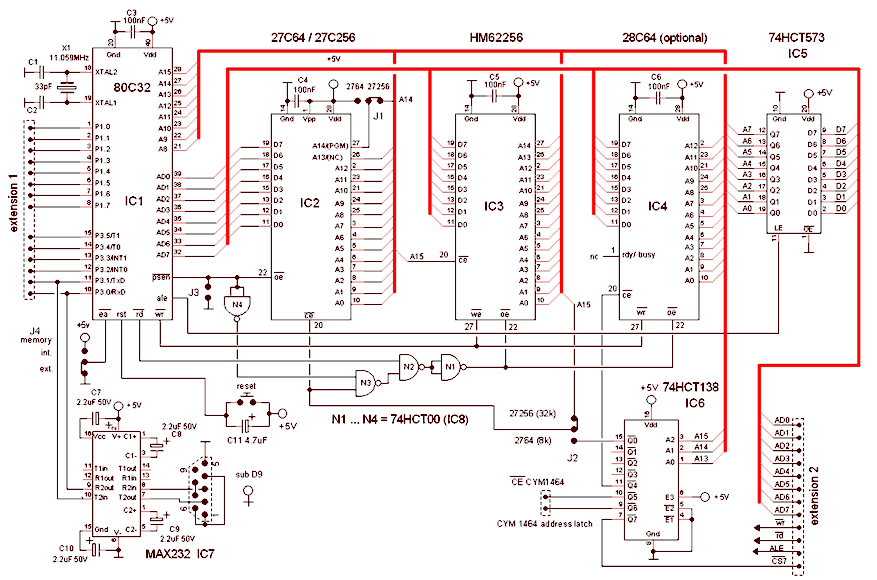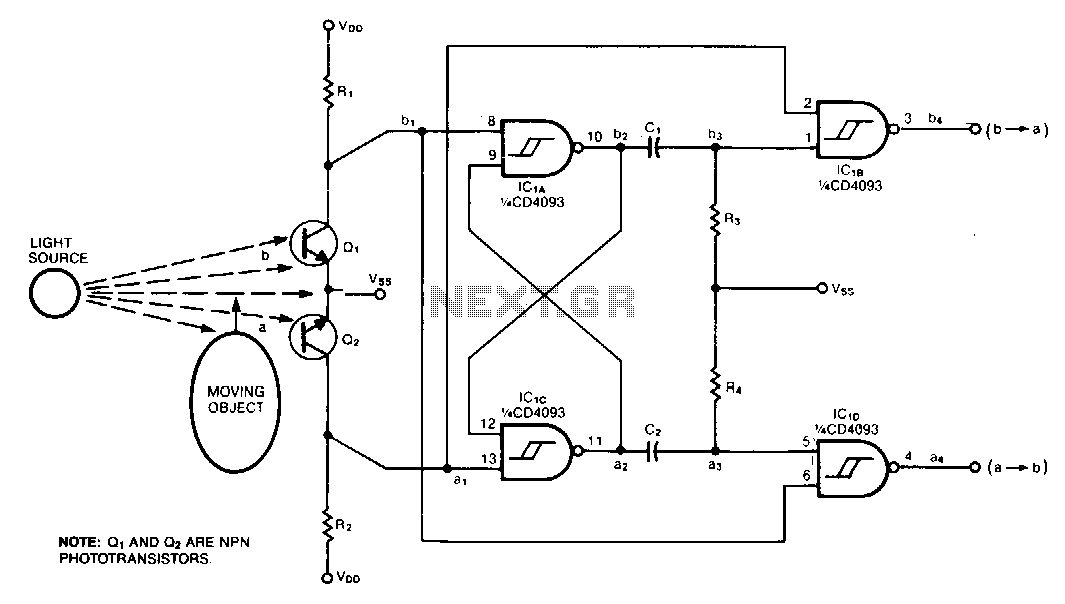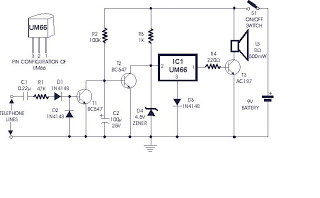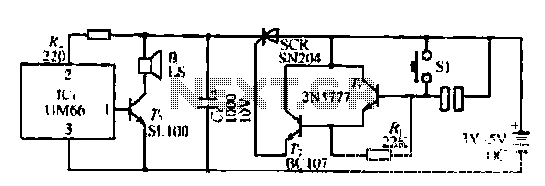
Sca background music decoder

A resistive voltage divider is utilized to establish a bias voltage for the input (pins 2 and 3). The demodulated FM signal is introduced to the input through a two-stage high-pass filter, which serves to provide capacitive coupling and to reduce the strong signal from the regular channel. The required total signal amplitude at the input ranges from 80 mV to 300 mV, with the source impedance needing to be less than 10,000 ohms. Additionally, the Phase Locked Loop is adjusted to 67 kHz using a 5000-ohm potentiometer; approximate tuning is sufficient, as the loop will automatically lock onto the signal. The demodulated output (pin 7) is processed through a three-stage low-pass filter to achieve de-emphasis and to minimize the high-frequency noise often present in SCA transmission. The demodulated output signal is approximately 50 mV, with a frequency response extending up to 7 kHz.
The circuit employs a resistive voltage divider to create a stable bias voltage necessary for the operational functionality of the input pins (2 and 3). This arrangement ensures that the biasing conditions are optimal for the subsequent processing stages. The inclusion of a two-stage high-pass filter prior to the input allows for effective capacitive coupling of the demodulated FM signal while simultaneously attenuating any unwanted strong signals from adjacent channels. This filtering stage is critical in maintaining signal integrity, especially when dealing with a required input amplitude that varies between 80 mV and 300 mV. The specification for the source impedance to be less than 10,000 ohms is essential to match the input characteristics of the subsequent stages and to prevent loading effects.
The Phase Locked Loop (PLL) is a key component in this design, tuned to 67 kHz using a 5000-ohm potentiometer. The design allows for approximate tuning, as the PLL is inherently capable of locking onto the desired frequency signal, thus ensuring stable operation and reliable demodulation of the FM signal.
Following demodulation, the output at pin 7 is subjected to a three-stage low-pass filter. This filtering stage is designed to provide de-emphasis, which is crucial in SCA (Subsidiary Communications Authorization) transmission to counteract the pre-emphasis applied at the transmitter. Moreover, the low-pass filter effectively attenuates high-frequency noise that may be introduced during transmission or processing, enhancing the overall quality of the demodulated output signal. The output signal, approximately 50 mV, is well within the operational parameters, and the frequency response of the circuit extends to 7 kHz, ensuring adequate fidelity for audio applications.A resistive voltage divider is used to establish a bias voltage for the input (pins 2 and 3). The demodulated (multiplex) FM signal is fed to the input through a two-stage high-pass filter, both to effect capacitive coupling and to attenuate the strong signal of the regular channel. A total signal amplitude, between 80 mV and 300 mV, is required at the input. Its source should have an impedance of less than 10,000 ohms The Phase Locked Loop is tuned to 67 kHz with a 5000 ohm potentiometer; only approximate tuning is required, since the loop will seek the signal. The demodulated output (pin 7) passes through a three-stage low-pass filter to provide de-emphasis and attenuate the high-frequency noise which often accompanies SCA transmission.
The demodulated output signal is in the rder of 50m V and the frequency response extends to 7 kHz. 🔗 External reference
The circuit employs a resistive voltage divider to create a stable bias voltage necessary for the operational functionality of the input pins (2 and 3). This arrangement ensures that the biasing conditions are optimal for the subsequent processing stages. The inclusion of a two-stage high-pass filter prior to the input allows for effective capacitive coupling of the demodulated FM signal while simultaneously attenuating any unwanted strong signals from adjacent channels. This filtering stage is critical in maintaining signal integrity, especially when dealing with a required input amplitude that varies between 80 mV and 300 mV. The specification for the source impedance to be less than 10,000 ohms is essential to match the input characteristics of the subsequent stages and to prevent loading effects.
The Phase Locked Loop (PLL) is a key component in this design, tuned to 67 kHz using a 5000-ohm potentiometer. The design allows for approximate tuning, as the PLL is inherently capable of locking onto the desired frequency signal, thus ensuring stable operation and reliable demodulation of the FM signal.
Following demodulation, the output at pin 7 is subjected to a three-stage low-pass filter. This filtering stage is designed to provide de-emphasis, which is crucial in SCA (Subsidiary Communications Authorization) transmission to counteract the pre-emphasis applied at the transmitter. Moreover, the low-pass filter effectively attenuates high-frequency noise that may be introduced during transmission or processing, enhancing the overall quality of the demodulated output signal. The output signal, approximately 50 mV, is well within the operational parameters, and the frequency response of the circuit extends to 7 kHz, ensuring adequate fidelity for audio applications.A resistive voltage divider is used to establish a bias voltage for the input (pins 2 and 3). The demodulated (multiplex) FM signal is fed to the input through a two-stage high-pass filter, both to effect capacitive coupling and to attenuate the strong signal of the regular channel. A total signal amplitude, between 80 mV and 300 mV, is required at the input. Its source should have an impedance of less than 10,000 ohms The Phase Locked Loop is tuned to 67 kHz with a 5000 ohm potentiometer; only approximate tuning is required, since the loop will seek the signal. The demodulated output (pin 7) passes through a three-stage low-pass filter to provide de-emphasis and attenuate the high-frequency noise which often accompanies SCA transmission.
The demodulated output signal is in the rder of 50m V and the frequency response extends to 7 kHz. 🔗 External reference
